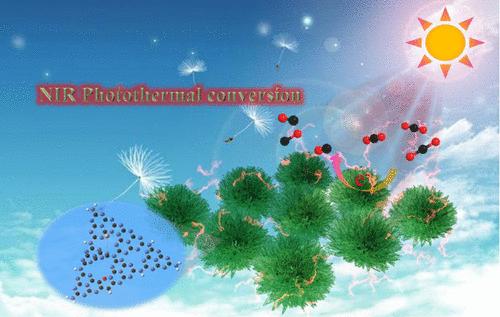近红外光热效应促进黑ga掺杂氮化碳光催化CO2还原
IF 3.9
3区 工程技术
Q2 ENGINEERING, CHEMICAL
引用次数: 0
摘要
有效利用太阳能光催化将CO2还原为CO,特别是在可见光和近红外波段,仍然具有挑战性。在此,我们报道了一种独特的具有有效光热转换的掺镓氮化碳(DFCN-Ga)。用无模板溶剂热法成功地修饰了具有黑色外观的蒲公英花状形态。采用多种方法对催化剂进行了表征,结果表明,该催化剂具有花瓣状片状重叠的簇状结构,比表面积大(105.6 m2/g),光吸收范围宽(300-1500 nm,通过UV-vis DRS光谱确定)。通过设置不同的光照条件来评价DFCN-Ga对CO2还原的光热催化活性。在全光谱下,在没有外界加热的情况下,模拟太阳光照下,以DFCN-Ga为催化剂的CO产率(98.2 μmol·h-1·g-1)比以石墨化碳(GCN)为催化剂的CO产率高16.1倍。结果表明,红外光有效地增强了催化剂的光催化活性。为了研究反应途径,采用密度泛函理论方法研究结构变化在光催化反应中的作用。结果表明,DFCN-Ga能有效分离HOMO和LUMO轨道,降低*COOH生成的自由能,显著提高CO2光催化还原CO的速率。我们的研究为全谱高效催化剂的合成和应用提供了一条独特的途径。本文章由计算机程序翻译,如有差异,请以英文原文为准。

Near-Infrared Photothermal Effect Boosting Photocatalytic CO2 Reduction by Black Ga-Doped Carbon Nitride
Efficient use of solar energy for photocatalytic reduction of CO2 into CO, especially in the visible and NIR ranges, remains challenging. Herein, we report a unique gallium-doped carbon nitride (DFCN-Ga) with effective photothermal conversion. The dandelion flower-like morphology with a black appearance was successfully modified using a template-free solvothermal method. The catalyst was characterized by various methods, which showed that it had a cluster structure with overlapping petal-like sheets, a large specific surface area (105.6 m2/g), and a wide light absorption range (300–1500 nm, as determined by UV–vis DRS spectra). Different illumination conditions were set up to evaluate DFCN-Ga’s photothermal-catalytic activity for CO2 reduction. Under full-spectrum light, without external heating, the yield of CO (98.2 μmol·h–1·g–1) with DFCN-Ga as the catalyst under simulated solar light was 16.1 times higher than that achieved with graphitic carbon nitride (GCN). The results showed that infrared light effectively enhanced the catalysts’ photocatalytic activity. To investigate the reaction pathway, the density functional theoretical method was used to study the role of structural changes in the photocatalytic reaction. It was found that DFCN-Ga could effectively separate HOMO and LUMO orbitals, lower the free energy of *COOH formation, and significantly increase the rate of CO2 to CO photocatalytic reduction. Our research provides a unique approach to the synthesis and application of high-efficiency catalysts with full-spectrum activity.
求助全文
通过发布文献求助,成功后即可免费获取论文全文。
去求助
来源期刊

Industrial & Engineering Chemistry Research
工程技术-工程:化工
CiteScore
7.40
自引率
7.10%
发文量
1467
审稿时长
2.8 months
期刊介绍:
ndustrial & Engineering Chemistry, with variations in title and format, has been published since 1909 by the American Chemical Society. Industrial & Engineering Chemistry Research is a weekly publication that reports industrial and academic research in the broad fields of applied chemistry and chemical engineering with special focus on fundamentals, processes, and products.
 求助内容:
求助内容: 应助结果提醒方式:
应助结果提醒方式:


